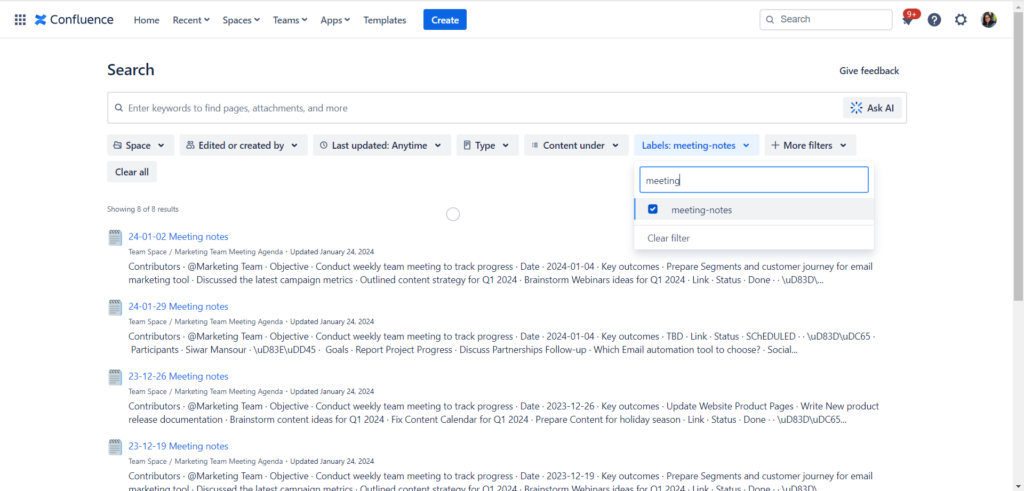There is nothing more frustrating than to wander around Confluence trying to locate and access pieces of content. Sure, Confluence is brilliant when it comes to collaboration and knowledge management. Adding to that the built-in Confluence search function, and finding content should be pretty much straightforward, right?
Well… wrong! Although Confluence search is good, every search function depends entirely on the content we produce, and especially how we can make it search friendly in some capacity. To put it simply, no matter how good your content is, if your target audience can’t easily search for it, then you are doing something wrong.
In this blog, we will share a couple of tips and best practices on how to optimize your content for better Confluence search results.
Tip #1: Make sure to use consistent keywords
Think of keywords as your key to open the door leading to information you need. Using the right keywords will unlock this door , allowing Confluence search to effectively translate requests and list relevant results.
Use relevant keywords consistently throughout your content, and try to mimic how your users typically search for information. To find your target keywords, consider leveraging tools from Atlassian Marketplace such as Viewtracker – Analytics for Confluence by Bitvoodoo.
With this app’ Search Report you can uncover the important keywords used across your Confluence site and align your content as such. The app also provides a list of other important reports to help you refine your keyword strategy.
But don’t stuff your content with too many keywords, though! Focus on creating relevant and coherent content. For instance, stick to your company terminology and keywords typically used in discussions, as there are naturally keywords your team members might use in searching for information.
Tip #2 Structure your Confluence content with page trees
The more content you create, the more you need to be organized. Otherwise, your Confluence spaces will be in complete chaos and your teams won’t be able to easily access content. This is when page trees come in handy as a way to structure your content into parent and child pages. This obviously allows your teams to seamlessly navigate their spaces and find what they are looking for.
With this being said though, it is always more convenient to just hit that search bar.
With your pages well organized, it can become easier to fine tune your search results. Confluence advanced search comes with a host of integrated filters designed for just that. In our example, the “Content under” filter allows you to display content under specific parent pages.
Tip #3: Categorize your content with labels
Labels are yet another way to better organize your content and make it search friendly. Think of them as advanced search filters giving you quick access to a collection of related content.
From within Confluence advanced search, you can further filter your search results using one or a combination of labels. For example, once you type release, all confluence pages containing the label “release” are listed in your search results.
To add labels to your Confluence page, just navigate to the bottom of the page and type the label you want to add or select from the labels list used across your space. You can filter your search results in Confluence by selecting specific labels.

Some might argue that labels or at least- too many of them-, can be counterproductive. And they would be right. So when you decide to tag your content with labels, always make sure to use a selective few and avoid labeling just for the sake of it.
Tip #4 Classify content with Confluence page statuses
While Confluence is yet to introduce the ability to filter your search results directly by page status, Confluence page status is still a valuable tool that provides more context when searching for information across your Confluence spaces. Users can clearly identify whether the content they are looking for is a draft page , in progress, done, etc.
Listed at the top of your Confluence page, this native feature gives you a clear indication of the page status. This allows your Confluence users to evaluate reliability and relevance of search results, making it easier to access the information they need.
Tip #5: Use timestamps to mark your content
Sometimes your Confluence space can include outdated content, or you just happen to look for pages from a specific date or time frame. Timestamps are an easy way to identify whether content is up to date and further narrow your search results.
Although Confluence advanced search allows you to show content from a specific time frame (past 7 days, month, etc), they don’t help to pinpoint a specific date. And that added information is key to enhancing search results.
You can incorporate timestamps within page titles for clear visibility, indicating the creation or last update date. This is particularly useful to keep track of meeting notes or product release notes.
This simple addition keeps your users informed about the timeliness of the content. So while users are searching for specific information, they can ensure to prioritize fresh and relevant information in their search results.
Tip #6: Leverage prefixes to distinguish pages
Prefixes are similar to labels, they are yet another way to categorize your content in Confluence. Just like Confluence labels spaces with categories, prefixes in page titles work the same way! You can use abbreviations similar to a space key in Confluence: “MKG” for Marketing materials, or “FIN” for Finance, etc. This will give your Confluence space users a quick glimpse into the pages’ content.
Once this approach is adopted throughout your Confluence instance, users will be able to identify content for search results easier and faster. You can type a well-established prefix in the Confluence search bar, and only retrieve pages containing that prefix, saving everyone valuable time in their search for information.
Tip #7: Continuously update and archive content
While it’s important to adopt some of these simple yet effective tips to optimize your Confluence content for better search results, what’s more crucial is to update and clean your existing content.
Through periodic reviews and updates, you should ensure your Confluence content remains relevant and accurate. But, Don’t just delete outdated information, though! Archive it with notes!
In Confluence Cloud, you can attach a note while you are archiving a page to provide more insights and context. This way, archived content remains accessible when needed, while keeping your search results focused on the updated and relevant information.
To access archived content, access Confluence Advanced Search, enter your search query and select the ‘Show archived content’.
So, now while users can search and access current information shared in Confluence space, they can always go back and gain more perspective with relevant archived pages.
Tip #8 Use dedicated marketplace apps for specific content
Confluence advanced search allows you to filter results based on various types including spaces, pages, comments, and more. However, when you go about creating your spaces and knowledge management hubs, one key thing is to use specialized apps for specific pieces of content.
For example, if you create an FAQ hub, a glossary, etc, you also want that content to be easily retrievable via Confluence search. Thanks to a deep integration with Atlassian Marketplace apps, you can choose from a variety of search types including but not limited to questions, answers, glossaries, and more.
And there you have it. Confluence search can be a powerful tool to help you and your teams better locate and search content across Confluence. As we said at the beginning, every search function depends entirely on the quality of the content you produce and whether it is search friendly. And remember, search functions these days get much better as you use them since they study your patterns and search history. So if you hate Confluence search at the start, follow our tips and give it time!
